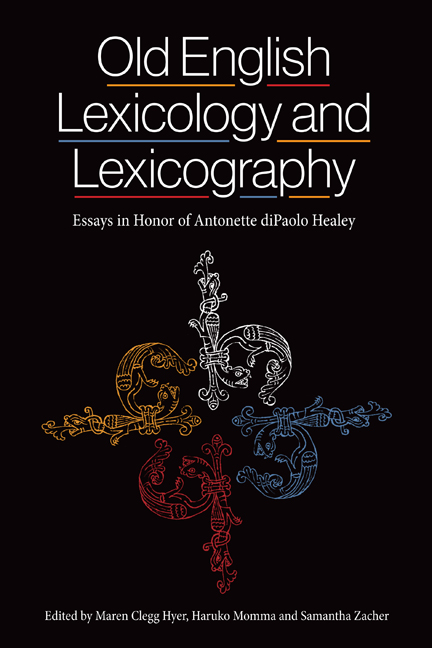Book contents
- Frontmatter
- Dedication
- Contents
- List of Illustrations
- List of Contributors
- Acknowledgements
- Abbreviations
- Introduction
- I Old English Poets and their Word-Craft
- 1 Beowulf and the Art of Invention
- 2 Juliana 53a Revisited (hætsð hæþenweoh)
- 3 Wounds and Compensation in the Old English Soul and Body Poems
- II Old English Homiletic Tradition
- 4 Defining and Redefining: Ælfric's Access to Gregory's Homiliae in Evangelia in the Composition of the Catholic Homilies
- 5 Lambeth Homily 4 and the Textual Tradition of the Visio Pauli
- 6 ‘A Vision of Souls’: Charity, Judgment, and the Utility of the Old English Vision of St. Paul
- 7 The Vocabulary of Sin and the Eight Cardinal Sins
- III Anglo-Saxon Institutions
- 8 The King (and Queen) and ‘I’: Self-Construction in Some Anglo-Saxon Royal Documents
- 9 Anglo-Saxon Maccabees: Political Theology in Ælfric's Lives of Saints
- 10 Nunne in Early Old English: Misogyny in its Literary Context
- IV Lexis of the Quotidian
- 11 Cingulum est custodiam: Semiotics and the Semantic Range of gyrdels
- 12 Island Time: The English Day and the Christian Hours
- 13 ‘Revising Hell’: The Voices of Teachers in Anglo-Saxon Studies and Anglo-Saxon England
- V The Task of the Lexicographer
- 14 Cryptography and the Lexicographer: Codifying the Code
- 15 Genre and the Dictionary of Old English
- Epilogue: Word-Hord
- 16 Reading Beowulf with Isidore's Etymologies
- An Old English Lexicon Dedicated to Toni Healey
- Toni Healey: A Tribute
- List of publications of Antonette diPaolo Healey
- Index
- Tabula Gratulatoria
- Miscellaneous Endmatter
- Anglo-Saxon Studies
11 - Cingulum est custodiam: Semiotics and the Semantic Range of gyrdels
Published online by Cambridge University Press: 17 September 2020
- Frontmatter
- Dedication
- Contents
- List of Illustrations
- List of Contributors
- Acknowledgements
- Abbreviations
- Introduction
- I Old English Poets and their Word-Craft
- 1 Beowulf and the Art of Invention
- 2 Juliana 53a Revisited (hætsð hæþenweoh)
- 3 Wounds and Compensation in the Old English Soul and Body Poems
- II Old English Homiletic Tradition
- 4 Defining and Redefining: Ælfric's Access to Gregory's Homiliae in Evangelia in the Composition of the Catholic Homilies
- 5 Lambeth Homily 4 and the Textual Tradition of the Visio Pauli
- 6 ‘A Vision of Souls’: Charity, Judgment, and the Utility of the Old English Vision of St. Paul
- 7 The Vocabulary of Sin and the Eight Cardinal Sins
- III Anglo-Saxon Institutions
- 8 The King (and Queen) and ‘I’: Self-Construction in Some Anglo-Saxon Royal Documents
- 9 Anglo-Saxon Maccabees: Political Theology in Ælfric's Lives of Saints
- 10 Nunne in Early Old English: Misogyny in its Literary Context
- IV Lexis of the Quotidian
- 11 Cingulum est custodiam: Semiotics and the Semantic Range of gyrdels
- 12 Island Time: The English Day and the Christian Hours
- 13 ‘Revising Hell’: The Voices of Teachers in Anglo-Saxon Studies and Anglo-Saxon England
- V The Task of the Lexicographer
- 14 Cryptography and the Lexicographer: Codifying the Code
- 15 Genre and the Dictionary of Old English
- Epilogue: Word-Hord
- 16 Reading Beowulf with Isidore's Etymologies
- An Old English Lexicon Dedicated to Toni Healey
- Toni Healey: A Tribute
- List of publications of Antonette diPaolo Healey
- Index
- Tabula Gratulatoria
- Miscellaneous Endmatter
- Anglo-Saxon Studies
Summary
The translation of a number of the most basic terms associated with textiles and textile production is often considered relatively straightforward. Hraegl represents cloth or a garment, web woven cloth, and so forth. However, most words and images we see related to textiles, like Old English words more generally, are rarely so transparent and direct in meaning. In this study, dedicated appropriately to my teacher and friend, one of the world's most pre-eminent definers of Old English words, Dr Antonette diPaolo Healey, I will examine ways in which the ‘meanings’ of textile words can prove as semiotic as semantic: each word is a sign that represents both letter sounds and a category or variety of possible objects and connotative elements and thus resists simple denotative translation. I will focus on the Old English word gyrdels as a case in point and investigate what we lose if we simply call a gyrdels a ‘girdle’.
Based on sight recognition, the Old English word gyrdel/gyrdels (which I am considering as two variants of the same word) might be easily defined and translated as a ‘girdle or belt’. That definition ignores, however, the range of contemporary denotations and connotations for the first word, girdle, which differ dramatically in some respects from the medieval dress equivalents, but it also ignores the complication that the meaning ‘belt’ is a latecomer to the discussion, occurring only in the late tenth and eleventh centuries, and even rarely, then.
More nuanced definitions for the term appear in dictionaries of Old English. In An Anglo-Saxon Dictionary, Joseph Bosworth and T. Northcote Toller give gyrdel/gyrdels four possible defintions, ‘girdle, belt, zone, purse’, and the Dictionary of Old English an even wider range, including ‘belt’, ‘girdle’, ‘pouch/purse’, ‘the part of the body around which the belt is fastened’, and ‘zone or region of the earth’, in addition to its meanings in glossing Latin words for ‘belt’, ‘girdle’, ‘twisted band’, ‘breast-band’, ‘buckle or strap for fastening a belt’, and ‘sword-belt’.
- Type
- Chapter
- Information
- Old English Lexicology and LexicographyEssays in Honor of Antonette diPaolo Healey, pp. 175 - 185Publisher: Boydell & BrewerPrint publication year: 2020



